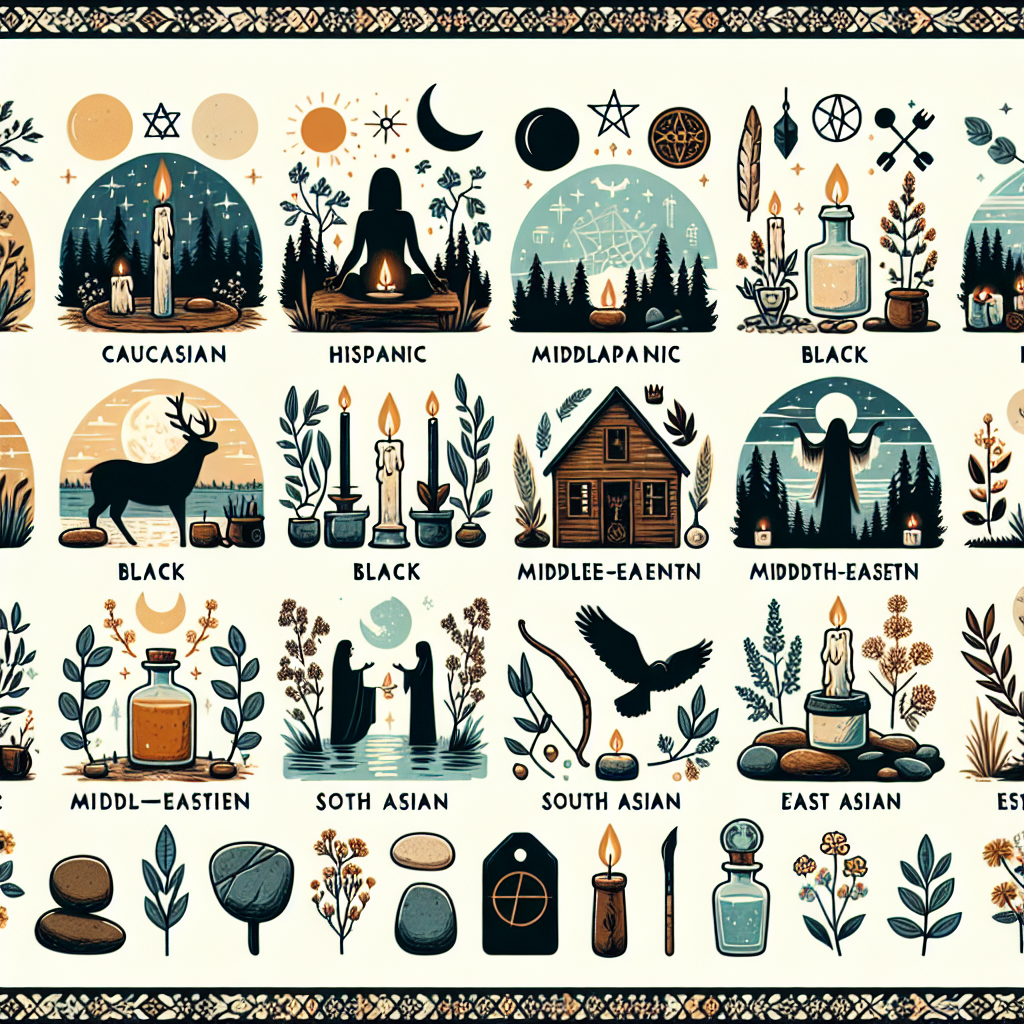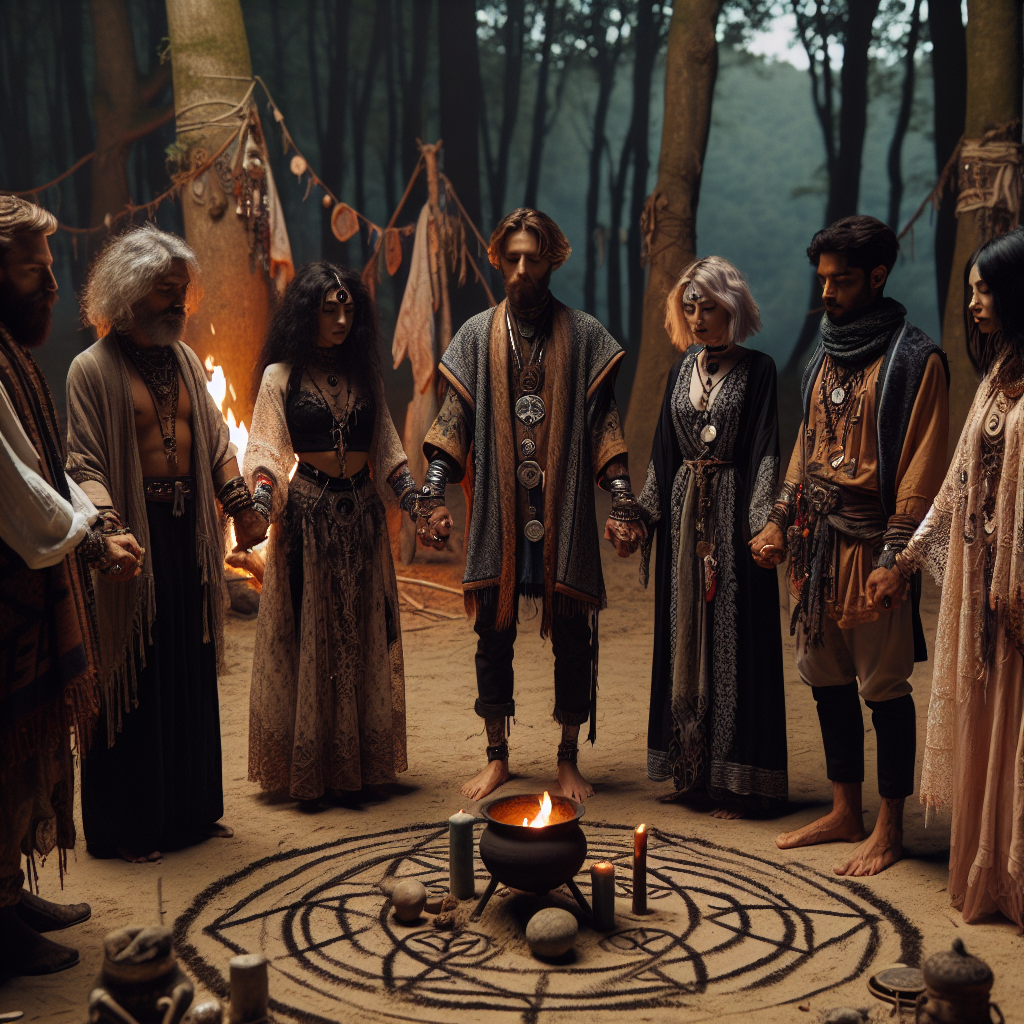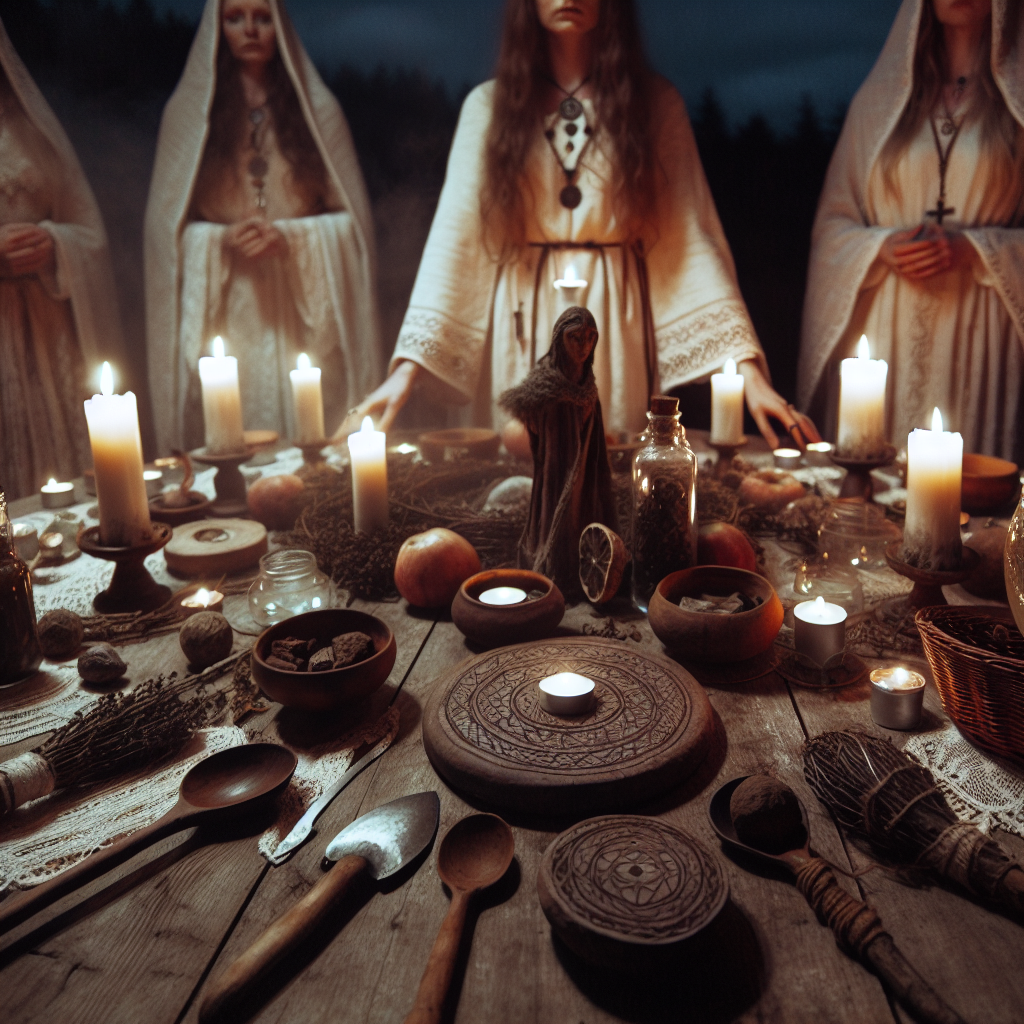As an Amazon Associate I earn from qualifying purchases.

“`html
Introduction to 12 Sacred Rituals for Practicing Pagans
Modern Paganism, with its roots tracing back to ancient pre-Christianity belief systems, emphasizes the connection between nature and spirituality. One of the cornerstones of modern Pagan practice includes the observance of 12 sacred rituals, each playing a vital role in connecting practitioners to the cycles of nature and the divine.
Historically, these rituals date back to ancient civilizations like the Celts, Greeks, and Norse, who honored the changing seasons and celestial events with various ceremonies. Today, the practice of these rituals has seen a resurgence, finding relevance in the modern-day through their focus on ecological awareness and personal spiritual growth.
The Structure of the 12 Sacred Rituals
Seasonal Celebrations
A significant element of the 12 sacred rituals is the celebration of the seasonal Wheel of the Year. This includes eight Sabbats: Samhain, Yule, Imbolc, Ostara, Beltane, Litha, Lughnasadh, and Mabon. These festivals mark seasonal changes and agricultural milestones, providing practitioners with a way to honor the earth’s bounty and rhythms.
Esbats and Lunar Phases
In addition to the Sabbats, many Pagans also observe Esbats, which are rituals tied to the phases of the moon. New moons and full moons hold particular importance as times for reflection, magic, and connection to the Goddess, fostering a deeper sense of alignment with lunar energies and their influence on life.
Personal and Community Rituals
Another set of sacred practices includes both personal rituals and those that are more communal. Personal rituals might encompass daily meditations, offerings to deities, or individual magical workings. Community rituals tend to involve group ceremonies, such as handfastings (Pagan weddings), naming ceremonies, and rites of passage, which strengthen communal bonds and shared spiritual beliefs.
Significance of the Sacred Rituals Today
These rituals not only honor ancient traditions but also serve modern needs. For instance, incorporating the 12 sacred rituals into one’s life can significantly improve mental and emotional health. A recent survey indicated that 78% of practicing Pagans feel a marked improvement in their overall well-being due to their ritualistic practices.
Moreover, these rituals provide a structured way for Pagans to engage with ecospirituality, promoting sustainability and environmental stewardship. As climate concerns grow, the principles observed in these rituals underscore the importance of living in harmony with nature, attracting more people to Pagan practices as a holistic solution for personal and ecological issues.
“`
1. **Wheel of the Year Celebrations**
One of the most integral pagan rituals involves celebrating the Wheel of the Year, which marks eight sabbats or seasonal festivals: Samhain, Yule, Imbolc, Ostara, Beltane, Litha, Lammas, and Mabon. These sacred practices honor the cyclical changes of nature and the shifting energies associated with each phase.
2. **Moon Rituals**
Lunar phases hold significant spiritual importance in Pagan ceremonies. Full moon and new moon rites are commonly performed to harness the moon’s energy for various magical workings. Many pagans perform esbats during the full moon, engaging in practices such as divination, spell-casting, and meditation.
3. **Dedication and Initiation Rites**
Dedication ceremonies are a form of sacred initiation for individuals committing themselves to a particular path or deity. These rituals often involve symbolic actions such as anointing with oils, taking vows, and receiving ritual items to signify the individual’s new spiritual journey.
4. **Handfasting Ceremonies**
In pagan traditions, handfasting is a sacred practice symbolizing a union similar to marriage. This spiritual rite involves binding the hands of the couple with a cord, ribbon, or cloth and reciting vows. The ritual is deeply symbolic of unity, partnership, and the binding of life paths.
5. **Seasonal Feasts**
Feasting is a central component of many pagan ceremonies, often used to honor deities, celebrate life’s bounty, and connect with community. Specific foods and beverages that correspond to individual sabbats or magical intentions are consumed, making these gatherings rich in sacred symbolism.
6. **Divination Practices**
Divination is another key aspect of pagan traditions, performed to gain insight and guidance from the divine. Methods include tarot readings, runes, scrying, and various forms of augury. These practices serve as a spiritual rite to communicate with higher powers and the subconscious mind.
7. **Rites of Passage**
Pagans often perform specific rituals to mark significant life milestones, such as births, naming ceremonies, coming-of-age, and death rites. These rituals are designed to honor the transitions and growth stages of a person’s life within the spiritual community.
8. **Creating Sacred Space**
Before engaging in spiritual rites, pagans often create a sacred space to perform their rituals. This can involve casting a circle, calling upon the elements, and invoking deities. The creation of a sacred space is crucial for focusing energy and ensuring spiritual protection during the ceremony.
9. **Solitary Rituals**
Many pagans practice their spirituality alone and engage in solitary rituals. These can range from daily devotional practices to more elaborate ceremonies like spell-casting and meditative journeys. Personalizing these rituals allows for a deeply individual connection to spiritual forces.
10. **Nature-Based Rituals**
Connection with nature is a fundamental element of pagan spirituality. Rituals performed in natural settings, such as forests, rivers, and mountains, are designed to honor the Earth and its natural cycles. Offerings, prayers, and meditations in these surroundings are common sacred practices.
11. **Ancestor Veneration**
Honoring ancestors is a profound and ancient pagan tradition. Rituals may include setting up altars with ancestral photographs and belongings, offering food and drink, and performing rituals that invite ancestral wisdom and protection. This practice maintains a deep connection with one’s lineage.
12. **Sacred Dance and Music**
Dance and music hold powerful symbolic and magical significance in pagan ceremonies. Ritual dancing can invoke trance states, raise energy, and connect participants to divine rhythms. Drumming, chanting, and singing also play vital roles in energizing and focusing spiritual rites.
Paganism continues to be a vital and growing spiritual path, with an increase in practitioners over recent years. Research indicates that the contemporary pagan community is expanding, with a notable rise in the number of individuals identifying as pagans in recent surveys.
u003ch2u003eSamhain Ritualu003c/h2u003e
u003cpu003eThe first time I participated in a Samhain ritual, I felt a profound connection to my ancestors and the cycle of life and death. It was held in a secluded forest, where the ambience was calm and the air was crisp. We created an altar adorned with photographs and mementos of loved ones who had passed away. Each participant shared stories, which made the ritual feel deeply personal and emotionally enriching.u003c/pu003e
u003cpu003eWe also performed a traditional bonfire ceremony, where each of us wrote down a fear or a negative aspect of our lives on a piece of paper and then burned it in the fire. As my paper turned to ash, I felt a sense of release and renewal wash over me. It was as though I had not only honored those who had passed but also made room for new growth in my life.u003c/pu003e
u003cpu003eThe evening ended with a communal feast, where we shared food and stories. This aspect of the ritual really emphasized the importance of community and interconnectedness. I left feeling not just spiritually fulfilled, but also deeply connected to the people who shared this sacred space with me.u003c/pu003e
u003ch2u003eYule Celebrationu003c/h2u003e
u003cpu003eYule has always been a favorite of mine, partly because of the joy and warmth it brings during the coldest part of the year. One year, I decided to host a Yule celebration in my home. We decorated the house with evergreen branches, holly, and mistletoe, filling the space with a sense of life and vitality.u003c/pu003e
u003cpu003eWe started the celebration with a Yule log ceremony. We selected a special log, decorated it, and carved symbols of protection and prosperity into it. As we burned it in the fireplace, we each took a moment to express our hopes and wishes for the coming year. The scent of the burning log filled the room, making the ritual feel complete and immersive.u003c/pu003e
u003cpu003eAfter the log ceremony, we sang traditional Yule songs and shared a hearty meal. The laughter, music, and food made me appreciate the simple joys in life and deepened my sense of gratitude. The Yule celebration not only honored ancient traditions but also reinforced my bond with everyone who attended.u003c/pu003e
u003ch2u003eBeltane Festivalu003c/h2u003e
u003cpu003eBeltane is another ritual that stands out in my memory, mainly because of its focus on fertility, growth, and new beginnings. One Beltane, I joined a large group of pagans in a huge open field where a towering Maypole had been erected. We each took a colored ribbon and danced around the Maypole in a spirited, intricate weave.u003c/pu003e
u003cpu003eAs the music played and our feet moved in sync, the act of weaving the ribbons felt symbolic of weaving our intentions and energies together. It was liberating and joyful. Later, we created flower crowns and wore them proudly, symbolizing the beauty and abundance of nature.u003c/pu003e
u003cpu003eThe festival also included various workshops on herbalism, drumming, and crafts. Each activity I took part in felt like another layer added to my spiritual practice. The Beltane festival created an environment where learning and celebration coexisted, enriching my connection to the Earth and all its living beings.u003c/pu003e
u003ch2u003eMabon Feastu003c/h2u003e
u003cpu003eMabon has always felt like a time of plenty, a pause to give thanks for the year’s bounties. I once attended a Mabon feast at a friend’s farmhouse, where the focus was on gratitude and sharing. The table was laden with seasonal produce, home-baked bread, and freshly pressed cider. Each guest brought a dish, making it a true communal effort.u003c/pu003e
u003cpu003eBefore the meal, we each took a moment to express what we were thankful for. It might seem like a small gesture, but hearing everyone’s various gratitudes created an atmosphere filled with positivity and mutual respect. The food felt even more nourishing, knowing it was prepared with such care and intention.u003c/pu003e
u003cpu003eAfterwards, we walked through the nearby orchards and fields, taking in the rich colors of autumn. The day ended with a small ritual where we offered some of the harvest back to the Earth, acknowledging the cycles of giving and receiving that sustain us. This Mabon feast grounded me in the rhythms of nature, enhancing my appreciation for the Earth’s generosity.u003c/pu003e
u003cH2u003eWhat are Pagan rituals?u003c/H2u003e
u003cpu003ePagan rituals are ceremonial practices rooted in ancient spiritual traditions. They are often designed to honor deities, connect with nature, mark the changing seasons, and celebrate life events. These rituals can vary widely depending on the specific Pagan path followed, such as Wicca, Druidry, or Heathenry.u003c/pu003e
u003cH2u003eDo I need specific tools or items to practice Pagan rituals?u003c/H2u003e
u003cpu003eWhile many Pagan rituals involve specific tools like candles, athames, chalices, and incense, the most important elements are the intent and focus of the practitioner. Tools can help create a sacred space and focus energy, but they are not strictly necessary.u003c/pu003e
u003cH2u003eCan anyone perform Pagan rituals, or do I need to be initiated?u003c/H2u003e
u003cpu003eAnyone interested in Pagan spirituality can perform ritual practices. Some traditions have initiation rites, but personal practice does not require formal initiation. It’s essential to approach these practices with respect and an understanding of their significance.u003c/pu003e
u003cH2u003eHow do Pagan rituals relate to the natural world?u003c/H2u003e
u003cpu003ePagan rituals often have a strong connection to the natural world, celebrating the cycles of the moon, the changing seasons, and the four elements (earth, air, fire, and water). These practices aim to attune practitioners with nature and its rhythms.u003c/pu003e
u003cH2u003eWhat is a sacred circle in Pagan rituals?u003c/H2u003e
u003cpu003eA sacred circle is a space created during a Pagan ritual to mark a boundary that separates the mundane world from the sacred. It’s typically cast at the beginning of a ritual to create a protected, focused environment for spiritual work.u003c/pu003e
u003cH2u003eCan Pagan rituals be performed indoors or must they be outside?u003c/H2u003e
u003cpu003ePagan rituals can be performed both indoors and outdoors. While many practitioners prefer outdoor settings to connect more directly with nature, indoor rituals can be equally effective, especially when space or weather conditions are limiting factors.u003c/pu003e
u003cH2u003eHow do I find a community for practicing Pagan rituals?u003c/H2u003e
u003cpu003eMany Pagan communities and covens can be found through local metaphysical shops, online forums, social media groups, and specialized Pagan gatherings like festivals and conferences. These communities can offer support, guidance, and opportunities for group rituals.u003c/pu003e
u003cH2u003eWhat are some common Pagan holidays?u003c/H2u003e
u003cpu003eCommon Pagan holidays include the eight Sabbats of the Wheel of the Year: Samhain, Yule, Imbolc, Ostara, Beltane, Litha, Lammas (or Lughnasadh), and Mabon. These holidays mark seasonal changes and are celebrated with various rituals and traditions.u003c/pu003e
u003cH2u003eAre there ethical guidelines in Paganism?u003c/H2u003e
u003cpu003eMany Pagan paths follow ethical guidelines such as the Wiccan Rede (“An it harm none, do what ye will”) or principles of respect for all living beings and the Earth. While specific rules vary, personal responsibility and ethical living are often emphasized.u003c/pu003e
u003cH2u003eHow can I learn more about Pagan rituals and practices?u003c/H2u003e
u003cpu003eTo learn more about Pagan rituals, consider reading books by reputable authors, attending Pagan workshops or events, joining online communities, and connecting with local practitioners. Personal study and experience are key to deepening your understanding and practice.u003c/pu003e

## Conclusion
Each of the 12 sacred rituals for practicing Pagans illustrates the diverse and profound ways in which individuals can deepen their spiritual connection to nature, the elements, and the divine. From the ritualistic celebratory dances of Beltane that usher in fertility and abundance, to the solemnity of Samhain, marking the thin veil between the worlds of the living and the dead, these practices underscore the cyclical nature of life and death. Rituals like full moon esbats and the invocation of elemental quarters emphasize the integration of lunar energies and elemental forces into daily spiritual practice, enhancing mindfulness and attunement to the universe’s rhythms.
The varied ceremonial rites such as handfasting and the Wheel of the Year Sabbats highlight the community and personal milestones that anchor Pagans in their traditions. These rites not only foster a sense of belonging but also provide a framework for personal growth and transformation. Sacred practices like divination and spellwork affirm the belief in the power of the intent and the unseen energies at play in the cosmos. By engaging in these time-honored traditions and ceremonies, Pagans reinforce their spiritual paths, enriching both their individual journeys and their collective heritage.
Amazon and the Amazon logo are trademarks of Amazon.com, Inc, or its affiliates.


